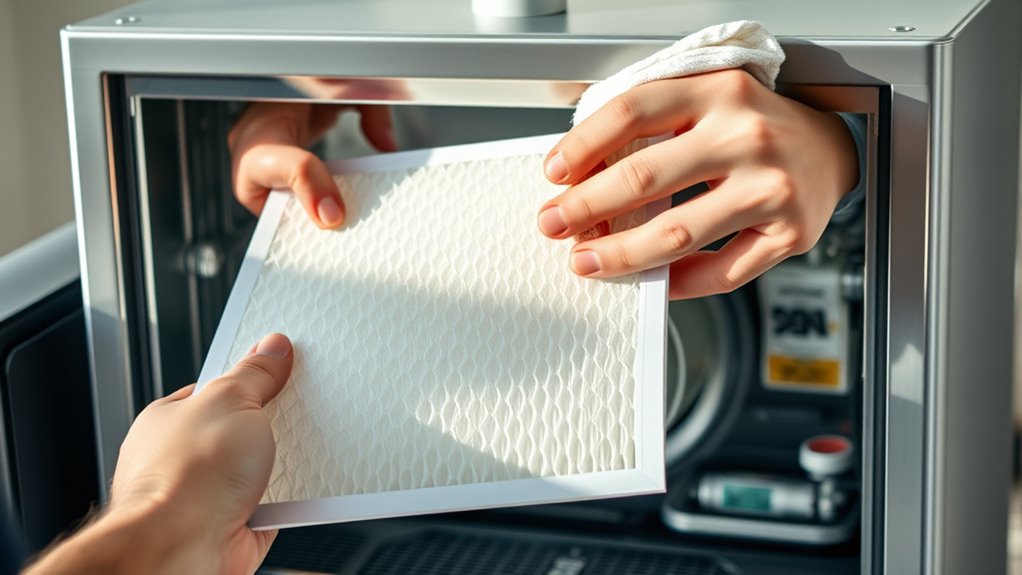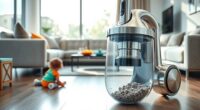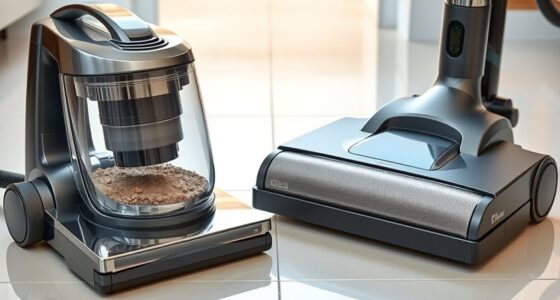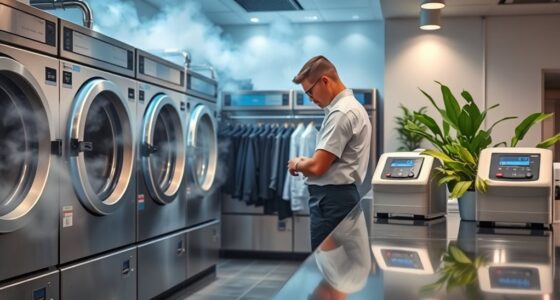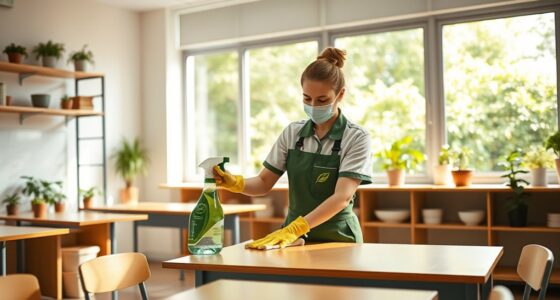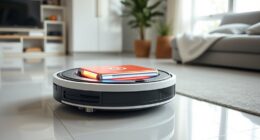Stop neglecting regular HEPA filter checks and using harsh chemicals or abrasive tools that can damage the filter. Instead, inspect your filters frequently, replace them when signs of wear appear, and use gentle cleaning methods like vacuuming or rinsing. Store filters properly when not in use and follow the manufacturer’s guidelines to maintain performance. Continuing with proper care ensures the best air quality and system efficiency—discover more tips to keep your system running smoothly.
Key Takeaways
- Stop neglecting regular inspections; instead, perform scheduled visual checks and airflow assessments to catch issues early.
- Avoid using harsh chemicals; opt for gentle cleaning methods like vacuuming or water rinsing as recommended by manufacturers.
- Don’t store filters in damp or humid environments; instead, keep them in dry, sealed containers to prevent damage.
- Refrain from ignoring signs of filter wear or damage; regularly inspect for tears, gaps, or debris buildup and replace promptly.
- Cease relying solely on appearance; instead, use airflow monitoring tools and follow manufacturer guidelines for maintenance intervals.
Cleaning or Replacing the Filter Too Infrequently
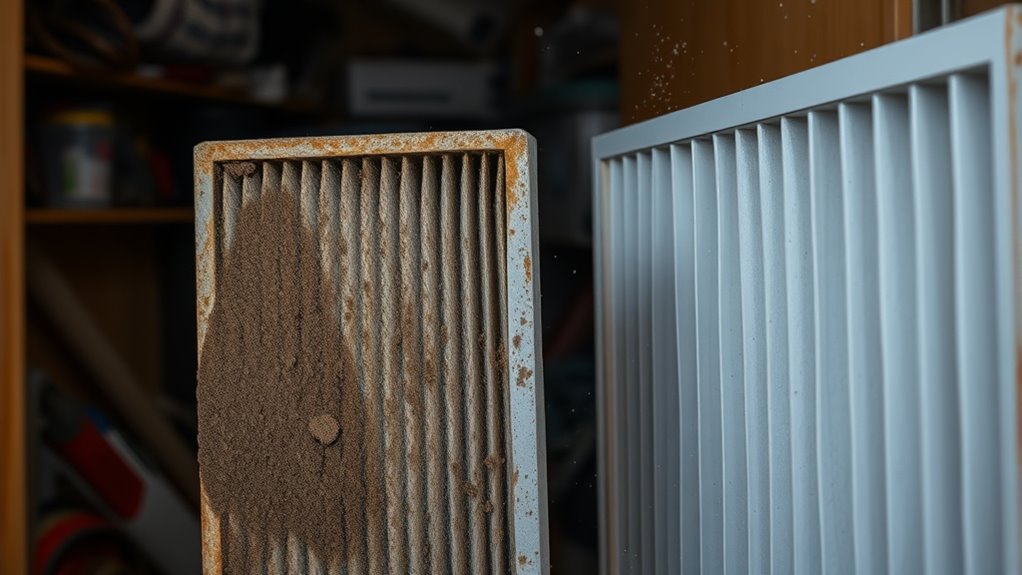
If you don’t clean or replace your HEPA filter regularly, it can become clogged with dust, dirt, and other particles, reducing its effectiveness. This can considerably shorten the filter lifespan and compromise your air quality. Infrequent maintenance increases the risk of airflow restrictions, making your device work harder and potentially leading to system damage. To prevent this, stick to the recommended maintenance frequency for your specific filter. Regular checks and timely replacements ensure your HEPA filter functions at its best and maintains its filtration capacity. Ignoring proper upkeep not only diminishes performance but also forces you to replace the filter prematurely, which can be costly. Additionally, understanding industry trends can help you stay informed about new filter technologies and best practices. Keep track of your filter’s condition and adhere to the suggested schedule for cleaning or replacing it.
Using Harsh Chemicals to Clean the Filter
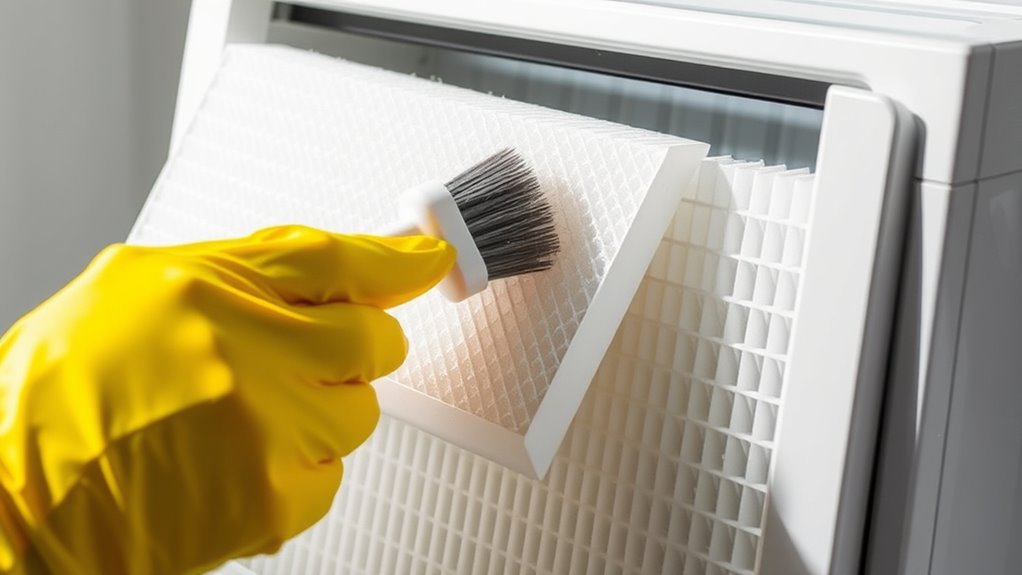
Using harsh chemicals to clean your HEPA filter can do more harm than good. Chemical cleaning with strong cleaners may seem effective, but it can damage the filter’s delicate fibers, reducing its efficiency. Harsh chemicals can leave residues that circulate in your air, potentially causing health issues. They might also degrade the filter material, shortening its lifespan and leading to more frequent replacements. Instead of risking damage, stick to gentle cleaning methods like vacuuming or rinsing with water, if permitted by the manufacturer. Always check your filter’s guidelines before using any cleaning solution. Proper maintenance, including understanding the filter’s specifications, ensures your HEPA filter stays effective and lasts longer. Remember, chemical cleaning isn’t worth compromising your filter’s integrity or your indoor air quality. Proper maintenance ensures your HEPA filter stays effective and lasts longer.
Ignoring Signs of Filter Wear and Tear
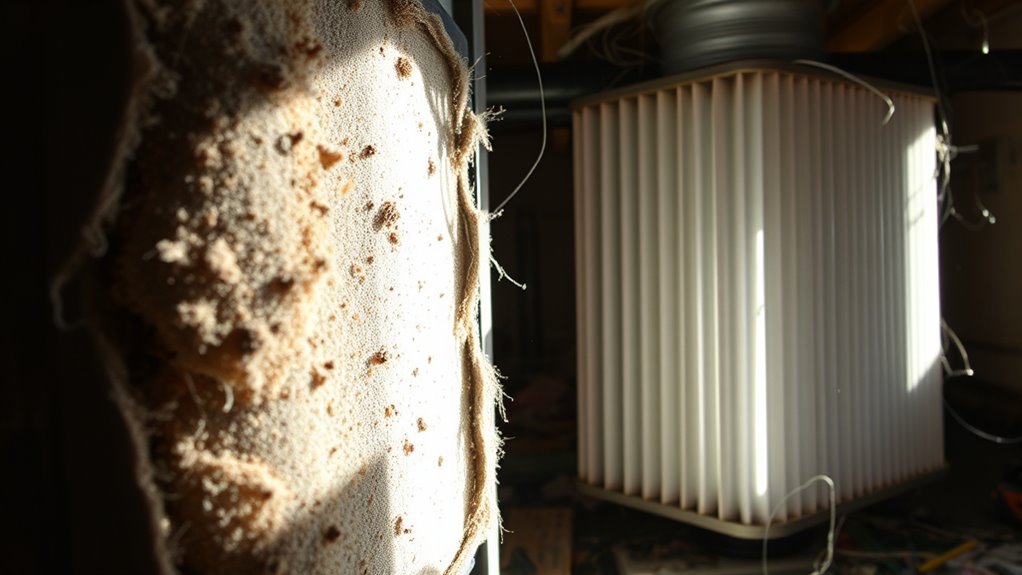
Have you noticed reduced airflow or increased allergy symptoms? Ignoring signs of filter wear and tear can shorten your filter lifespan and lead to inefficient performance. It’s essential to recognize these indicators early. Consider these points:
Reduced airflow and allergy symptoms signal filter issues—act early to protect your HVAC system’s efficiency.
- Visible dirt or debris buildup that doesn’t clear after cleaning
- Unpleasant odors emanating from your HVAC system
- Dust accumulation around vents despite regular maintenance
These signs suggest your filter is compromised and needs urgent attention. Skipping these cues can result in decreased air quality and higher energy bills. Regular inspections help you determine the right maintenance frequency, preventing premature filter replacement and ensuring peak filtration. Don’t wait until airflow diminishes or allergies worsen—stay vigilant and act promptly to maintain your system’s health.
Overlooking Proper Storage When Not in Use
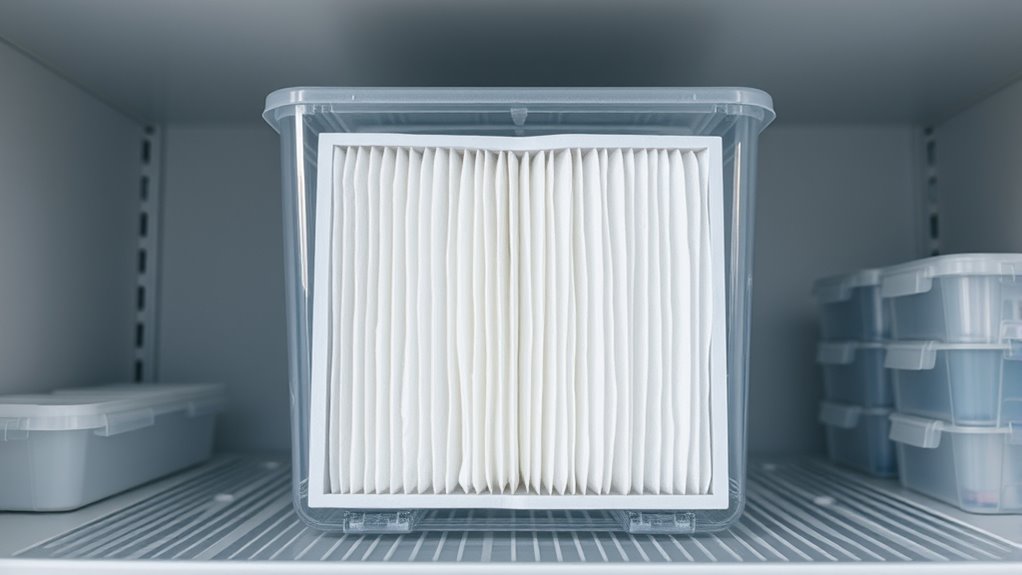
When you’re not using your HEPA filter, proper storage is essential to keep it effective. Make sure to store it in a dry area, seal it tightly, and keep it out of direct sunlight. These steps help prevent damage and maintain your filter’s performance. Additionally, storing filters in a controlled environment can prolong their lifespan and ensure optimal air purification when in use.
Store in Dry Area
Storing your Hepa filter in a dry area is essential to maintaining its effectiveness. Moisture buildup and temperature fluctuations can damage the filter’s fibers and reduce its filtration capacity. To guarantee ideal storage:
- Keep the filter in a location with consistent, moderate temperature to prevent warping or cracking.
- Avoid areas prone to humidity or dampness, which can cause moisture buildup.
- Use a sealed container or plastic bag when storing the filter to shield it from environmental changes.
- Be aware of data privacy challenges that can impact how you store and handle sensitive information related to your equipment.
Seal Filter Properly
Properly sealing your Hepa filter after storage prevents dust, dirt, and moisture from contaminating the fibers. You want to guarantee an airtight sealing to maintain its effectiveness. Use a suitable storage bag or container and apply the proper application techniques to create a secure seal. This prevents environmental elements from damaging the filter and extends its lifespan. Here’s a quick guide:
| Step | Action |
|---|---|
| 1 | Clean the filter thoroughly |
| 2 | Choose an airtight container |
| 3 | Place the filter inside |
| 4 | Seal tightly using proper application techniques |
| 5 | Store in a dry, cool place |
Following these steps helps keep your Hepa filter in ideal condition, ready for use when needed. Proper storage practices are essential for maintaining filter integrity and ensuring optimal performance when you need to use it again, aligned with filter maintenance best practices.
Avoid Sunlight Exposure
Exposing your HEPA filter to direct sunlight can cause the fibers to degrade more quickly, reducing its effectiveness and lifespan. UV light accelerates material breakdown, weakening the filter’s structure. To prevent this, store your filter properly when not in use:
- Keep it in a cool, shaded area away from direct sunlight.
- Ensure proper air circulation around the storage space to prevent moisture buildup.
- Use a breathable container to protect the filter from dust and UV exposure while allowing airflow.
- Regularly check your filter maintenance practices to ensure optimal performance and longevity.
Relying Solely on Visual Inspection to Assess Filter Condition
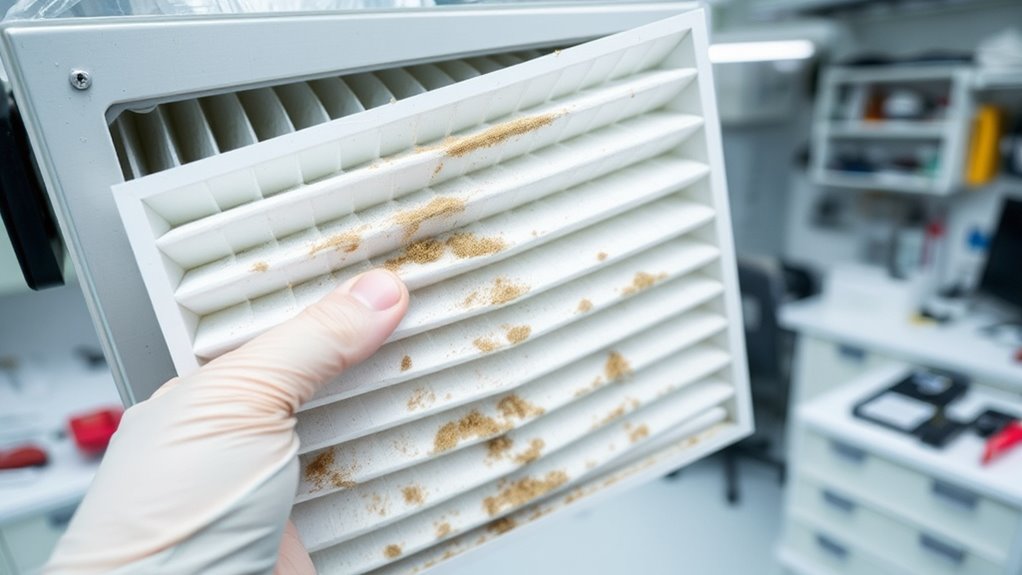
While visually inspecting your HEPA filters might seem like a straightforward way to determine their condition, relying solely on this method can be misleading. Dust and debris buildup may be invisible or minimal, yet your filter’s airflow efficiency can still decline. A filter that looks clean might have compromised fibers or damage that reduces its effectiveness. Over time, this impacts not only airflow but also shortens the filter’s lifespan, potentially leading to system strain or failure. Instead of just checking for visible dirt, consider using airflow monitoring tools or following manufacturer guidelines for replacement intervals. Relying solely on visual cues risks overlooking hidden issues that compromise filtration quality and system performance. Regular, thorough assessments ensure your filter functions at its best longer. Additionally, understanding filter performance metrics can help you better evaluate when a replacement is truly necessary.
Neglecting to Check the System’s Airflow and Seal Integrity
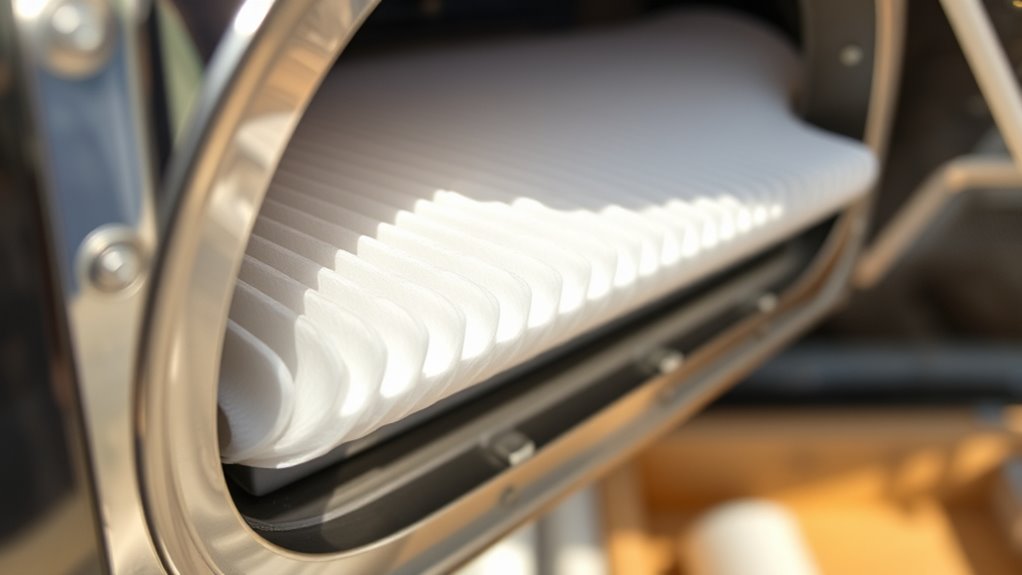
Neglecting to regularly check your system’s airflow and seal integrity can lead to significant performance issues. Poor airflow checks may cause your HEPA filter to work harder, reducing efficiency and lifespan. Additionally, compromised seal integrity allows unfiltered air to bypass the filter, decreasing air quality. To prevent these problems, you should:
- Conduct regular airflow checks to ensure consistent air movement throughout the system.
- Inspect seals around filters and duct connections for signs of wear or gaps.
- Tighten or replace seals promptly to maintain *ideal* system performance.
- Understanding airflow dynamics can help you identify potential issues before they escalate.
Using the Wrong Type of Cleaning Tools or Materials
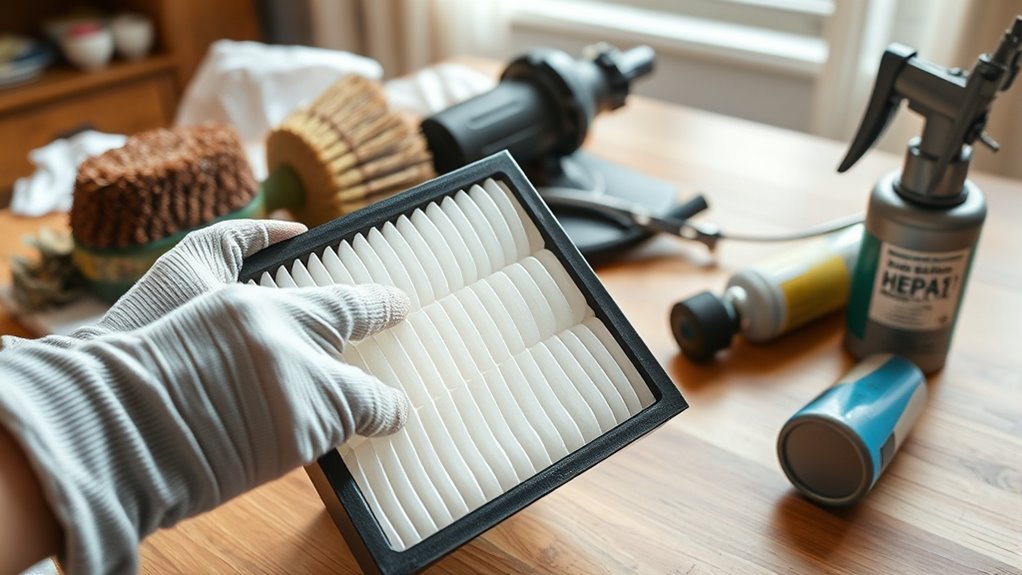
Using the wrong type of cleaning tools or materials can damage your HEPA filter and reduce its effectiveness. Harsh brushes or abrasive cleaners can tear the filter media, decreasing airflow efficiency and compromising filter compatibility. Instead, use a soft, damp cloth or a gentle vacuum attachment designed for filters. Avoid using chemicals or rough materials that might leave residues or cause tears.
| Cleaning Tool | Suitable for HEPA Filters | Not Suitable |
|---|---|---|
| Soft cloth | Yes | No |
| Gentle vacuum | Yes | No |
| Abrasive brush | No | Yes |
| Harsh chemicals | No | Yes |
Choosing the right tools is essential to maintaining maximum airflow and ensuring your HEPA filter continues to perform effectively.
Failing to Follow Manufacturer’s Maintenance Guidelines
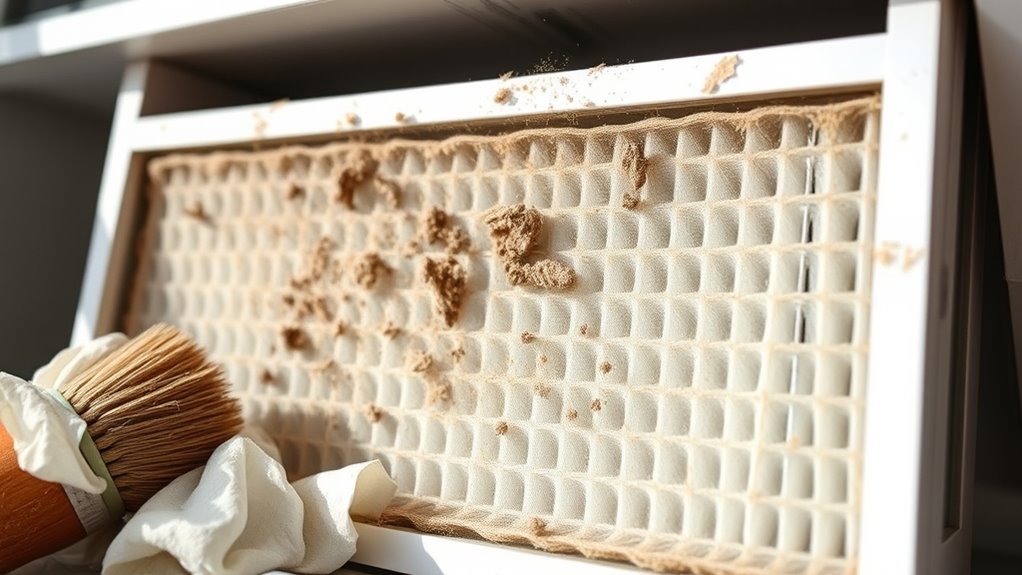
Failing to follow the manufacturer’s maintenance guidelines can lead to improper cleaning, premature filter failure, and reduced air quality. Ignoring these instructions disrupts your filter’s ideal performance. To avoid this, you should:
Ignoring manufacturer guidelines risks filter damage, reduced air quality, and shortened lifespan. Follow recommended maintenance for optimal performance.
- Adhere strictly to the recommended maintenance schedules provided by the manufacturer.
- Use only approved cleaning methods and materials specified in the manufacturer guidelines.
- Regularly check for updates to the guidelines to ensure you’re following current best practices.
- Incorporate data-driven strategies to monitor and optimize your filter’s performance over time.
Not following these steps can cause damage, void warranties, or diminish your filter’s lifespan. By respecting the manufacturer’s guidelines, you ensure your HEPA filter operates efficiently, maintains air purity, and lasts longer. Always review and follow the recommended maintenance schedules for the best results.
Frequently Asked Questions
How Often Should I Replace My HEPA Filter?
You should replace your HEPA filter every 6 to 12 months, depending on your filter’s lifespan and your usage. Regularly check the filter for signs of dirt and clogging, and follow the manufacturer’s recommended replacement schedule. Doing so guarantees peak air quality and efficiency. Keep in mind that high pollution levels or allergies may require more frequent replacements, so stay attentive to your filter’s condition.
Can I Wash My HEPA Filter With Soap and Water?
Imagine your HEPA filter as a delicate garden needing gentle care. You shouldn’t DIY clean it with soap and water, as moisture can damage the fibers and shorten its lifespan. Instead, trust the manufacturer’s guidance—most filters aren’t washable. Proper maintenance guarantees your filter works efficiently, extending its lifespan. Keep the filter dry, replace it when needed, and avoid risking damage that can compromise your air quality.
What Are the Signs My HEPA Filter Needs Urgent Replacement?
You’ll need to replace your HEPA filter urgently if you notice airflow reduction or persistent odors. Reduced airflow indicates the filter is clogged and can’t circulate air properly, while lingering smells suggest it’s no longer trapping particles effectively. Don’t ignore these signs; delaying replacement can worsen indoor air quality. Check your filter regularly, and replace it promptly to maintain peak performance and healthy indoor air.
How Do I Store My HEPA Filter Properly When Not in Use?
Think of your HEPA filter as a fragile treasure that needs careful storage. To guarantee proper handling, store it in a clean, dry place away from direct sunlight and humidity. Keep it in its original packaging or a sealed container to prevent dust and debris from settling. This way, when you’re ready to use it again, your filter remains effective, just like a treasured gem ready to serve its purpose.
Is It Necessary to Use Special Tools for Filter Maintenance?
You don’t need special tools for filter maintenance, but having basic tools like screwdrivers can make the process easier. Using the right tools helps you safely remove and replace your HEPA filter without damaging it. Avoid forcing or bending the filter, and always follow the manufacturer’s instructions. With proper tools and careful handling, filter maintenance becomes quicker and safer, ensuring your filter works efficiently for longer.
Conclusion
Stop making these common mistakes and give your HEPA filter the care it deserves. Think of your filter as a silent guardian—neglect it, and your indoor air quality suffers. By following proper maintenance practices, you guarantee a healthier environment and extend your filter’s lifespan. Remember, a well-maintained HEPA filter isn’t just a chore; it’s an investment in your well-being, a quiet testimony to the care you give your home.
